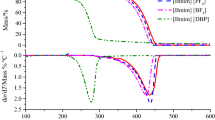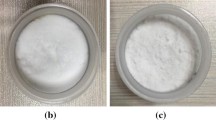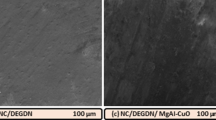Abstract
Novel nitrocellulose (NC)-based hybrid materials with self-synthesized heptaphenyltricycloheptasiloxane trihydroxy silanol (T7-POSS) as a modifier were prepared using a “one-step” chemical cross-linking process. To comprehensively demonstrate the superiority of the modifier, hybrid materials with different contents of T7-POSS were assessed. The gel content was measured, and the chemical structure and composition of the T7-POSS-NC hybrid materials were characterized by attenuated total reflection Fourier transform infrared spectroscopy (ATR-FTIR) and X-ray photoelectron spectroscopy (XPS). Thermogravimetric analysis (TGA) results showed that the thermal stability of the T7-POSS-NC hybrid materials increased with the T7-POSS content. Typically, when 12.3 wt.% T7-POSS was incorporated into the NC, the decomposition temperature based on 50% weight loss (T50%) was delayed from 183.3 °C to 243.5 °C, the maximum weight loss rate (WLRmax) decreased markedly from 432.9%/min to 1.3%/min, and the char residues increased from 1.4% to 26.0%. The scanning electron microscopy (SEM) results of the char residues indicated that the introduction of T7-POSS led to the formation of a sufficient and compact char layer. Notably, the incorporation of T7-POSS improved not only the combustion safety according to micro-scale combustion calorimeter (MCC) results but also the mechanical prop-erties due to the formation of cross-linking networks and the good distribution of T7-POSS particles, which was confirmed by SEM and energy-dispersive spectroscopy (EDS).












Similar content being viewed by others
Reference
Książczak A, Gołofit T, Tomaszewski W (2008) Binary system nitrocellulose from linters symdiethyldiphenylurea. J Therm Anal Calorim 91:375–380
Shukla MK, Hill F (2012) Theoretical investigation of reaction mechanisms of alkaline hydrolysis of 2,3,6-trinitro-β-d-glucopyranose as a monomer of nitrocellulose. Struct Chem 23:1905–1920
Książczak A, Ostrowski M (2004) DSC studies on long-term properties of nitrocellulose and SYM-diphenylurea system. J Therm Anal Calorim 77:341–351
Rychlý J, Lattuati-Derieux A, Matisová-Rychlá L, Csomorová K, Janigová I, Lavédrine B (2012) Degradation of aged nitrocellulose investigated by thermal analysis and chemiluminescence. J Therm Anal Calorim 107:1267–1276
Makashir PS, Mahajan RR, Agrawal JP (1995) Studies on kinetics and mechanism of initial thermal decomposition of nitrocellulose. J Therm Anal Calorim 45:501–509
Li R, Xu HM, Hu HL, Yang GC, Wang J, Shen JP (2014) Microstructured Al/Fe2O3/nitrocellulose energetic fibers realized by electrospinning. J Energ Mater 32:50–59
Xiao ZG, Ying SJ, He WD, Xu FM, Sun P (2007) Synthesis, morphology, component distribution, and mechanical properties of nitrocellulose/gradient poly(ethylene glycol dimethacrylate) semi-IPN material. J Appl Polym Sci 105:510–514
de Klerk WPC (2015) Assessment of stability of propellants and safe lifetimes. Propell Explos Pyrot 40:388–393
Zhao NN, Li JC, Gong HJ, An T, Zhao FQ, Yang AW, Hu RZ, Ma HX (2016) Effects of α-Fe2O3, nanoparticles on the thermal behavior and non-isothermal decomposition kinetics of nitrocellulose. J Anal Appl Pyrol 120:165–173
Zhang X, Hikal WM, Zhang Y, Bhattacharia SK, Li L, Panditrao S, Wang SR, Weeks BL (2013) Direct laser initiation and improved thermal stability of nitrocellulose/graphene oxide nanocomposites. Appl Phys Lett 102:141905–1(1–4)
Katoh K, Ito S, Ogata Y, Kasamatsu J, Miya H, Yamamoto M, Wada Y (2009) Effect of industrial water components on thermal stability of nitrocellulose. J Therm Anal Calorim 99:159–164
Raaijmakers MJT, Kappert EJ, Nijmeijer A, Benes NE (2015) Thermal imidization kinetics of ultrathin films of hybrid poly(POSS-imide)s. Macromolecules 48:3031–3039
Joseph AM, Nagendra B, Surendran KP, Gowd EB (2015) Syndiotactic polystyrene/hybrid silica spheres of POSS siloxane composites exhibiting ultralow dielectric constant. Acs Appl Mater Inter 7:19474–19483
Neyertz S, Brown D, Raaijmakers MJT, Benes NE (2016) A molecular characterization of hyper-cross-linked hybrid polyPOSS-imide networks. Comp Mater Sci 117:338–353
Huang JC, He CB, Xiao Y, Mya KY, Dai J, Siow YP (2003) Polyimide/POSS nanocomposites: interfacial interaction, thermal properties and mechanical properties. Polymer 44:4491–4499
Kopesky ET, Mckinley GH, Cohen RE (2006) Toughened poly(methyl methacrylate) nanocomposites by incorporating polyhedral oligomeric silsesquioxanes. Polymer 47:299–309
Bershtein V, Fainleib A, Egorova L, Grigoryeva O, Kirilenko D, Konnikov S, Ryzhov V, Starostenko O, Yakushev P, Yagovkina M, Saiter JM (2015) The impact of ultra-low amounts of introduced reactive POSS nanoparticles on structure, dynamics and properties of densely cross-linked cyanate ester resins. Eur Polym J 67:128–142
González-Campo A, Núñez R, Viñas C, Boury B (2006) Synthetic approaches to the preparation of hybrid network materials incorporating carborane clusters. New J Chem 30:546–553
Clough RL (2001) High-energy radiation and polymers: a review of commercial processes and emerging applications. Nucl Instrum Meth A 185:8–33
Cheng JJ, Pan Y, Zhu JT, Li ZZ, Pan JA, Ma ZS (2014) Hybrid network CuS monolith cathode materials synthesized via facile in situ, melt-diffusion for Li-ion batteries. J Power Sources 257:192–197
Wang L, Zheng S (2012) Surface morphology and dewettability of self-organized thermosets involving epoxy and POSS-capped poly(ethylene oxide) telechelics. Mater Chem Phys 136:744–754
Yin G, Zhang L, Li Q (2016) Preparation and characterization of POSS-cross-linked PCL based hybrid materials. J Polym Res 23:1–11
Zhang Y, Mao Y, Chen D, Wu WB, Yi SP, Mo SB, Huang C (2013) Synthesis and characterization of addition-type silicone rubbers (ASR) using a novel cross linking agent PH prepared by vinyl-POSS and PMHS. Polym Degrad Stabil 98:916–925
Xiang K, He L, Li Y, Xu C, Li S (2015) Dendritic AIE-active luminogens with a POSS core: synthesis, characterization, and application as chemosensors. RSC Adv 5:97224–97230
Vahabi H, Ferry L, Longuet C, Otazaghine B, Negrell-Guirao C, David G, Lopez-Cuesta JM (2012) Combination effect of polyhedral oligomeric silsesquioxane (POSS) and a phosphorus modified PMMA, flammability and thermal stability properties. Mater Chem Phys 136:762–770
Hablot E, Zheng D, Bouquey M, Avérous L (2008) Polyurethanes based on castor oil: kinetics, chemical, mechanical and thermal properties. Macromol Mater Eng 293:922–929
Jiang SH, Yang HY, Qian XD, Shi YQ, Zhou KQ, Xu HY, Shan XY, Lo SM, Hu Y, Gui Z (2014) A novel transparent cross-linked poly (methyl methacrylate)-based copolymer with enhanced mechanical, thermal, and flame-retardant properties. Ind Eng Chem Res 53:3880–3887
Baimark Y (2012) Morphology and thermal stability of cross-linked silk fibroin microparticles prepared by the water-in-oil emulsion solvent diffusion method. Asia Pac J Chem Eng 7:112–117
Teo JKH, Teo KC, Pan B, Xiao Y, Lu XH (2007) Epoxy/polyhedral oligomeric silsesquioxane (POSS) hybrid networks cured with an anhydride: cure kinetics and thermal properties. Polymer 48:5671–5680
Yang H, Yang CQ, He QL (2009) The bonding of a hydroxy-functional organophosphorus oligomer to nylon fabric using the formaldehyde derivatives of urea and melamine as the bonding agents. Polym Degrad Stabil 94:1023–1031
Fan H, Yang R (2013) Flame-retardant polyimide cross-linked with polyhedral oligomeric octa(aminophenyl)silsesquioxane. Ind Eng Chem Res 52:2493–2500
Fernández MD, Fernández MJ, Cobos M (2016) Effect of polyhedral oligomeric silsesquioxane (POSS) derivative on the morphology, thermal, mechanical and surface properties of poly(lactic acid)-based nanocomposites. J Mater Sci 51(7):3628–3642
Acknowledgements
The authors thank the National Natural Science Foundation of China (No. 21474008).
Author information
Authors and Affiliations
Corresponding author
Rights and permissions
About this article
Cite this article
Yang, X., Li, Y., Wang, Y. et al. Nitrocellulose-based hybrid materials with T7-POSS as a modifier: effective reinforcement for thermal stability, combustion safety, and mechanical properties. J Polym Res 24, 50 (2017). https://doi.org/10.1007/s10965-017-1203-x
Received:
Accepted:
Published:
DOI: https://doi.org/10.1007/s10965-017-1203-x




